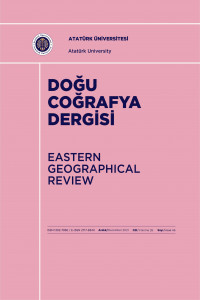Öz
Küresel ısınma çerçevesinde Süphan dağı buzullarında meydana gelen değişmeleri inceleyen bu çalışmanın temel amacı, Türkiye’nin doğu bölümündeki iklimsel değişmelerin yönünü ve hızını ortaya koymaktır. Bunun yanında son yıllarda bilimsel gündemde önemli bir yere sahip olan küresel ısınmanın Türkiye’nin doğusunda gerçekten etkin olup olmadığı, etkinse bu etkinin ne şiddette gerçekleştiği gibi sorulara yanıt aramaktır. Bunun için Türkiye’nin, üzerinde buzul bulunan en yüksek 3-4 dağından biri olan Süphan seçilmiştir. Bu amaca ulaşmak için, öncelikle hava fotoğraflarından, daha önce yapılmış araştırmalardaki bilgi ve belgeler ile arazi çalışmalarından yararlanılmıştır. Böylece 19. yüzyıl sonundan günümüze kadar, yüz yıldan daha uzun bir sürenin gözlemlenmesi mümkün olmuştur. Ulaşılan sonuçlar ise çarpıcıdır. 19. yüzyıl sonunda, 2.5-3 kilometre uzunluğunda, 400 metre eninde ve 70-100 metre derinliğindeki Süphan kalderasını hemen tamamen dolduran buzullar, geçen zaman içinde eriyerek bütünüyle ortadan kalkmıştır. Bu sonuçlar, 19. yüzyılın ikinci yarısından sonra başlayan ve gittikçe şiddetlenen hızlı bir ısınmayı işaret etmektedir.
Anahtar Kelimeler
İklim değişmeleri küresel ısınma buzullardaki değişmeler Süphan Dağı hava fotoğrafları
Destekleyen Kurum
TÜBİTAK
Proje Numarası
101Y131
Teşekkür
Bu makale TÜBİTAK, “Yer, Deniz ve Atmosfer Bilimleri Araştırma Grubu” bünyesinde hazırlanan 101Y131 no’lu projeden üretilmiştir. Bu nedenle TÜBİTAK yönetici ve çalışanlarına teşekkürlerimizi sunarız.
Kaynakça
- Bradshaw, M. ve Weaver, R. (1995). Foundations of Physical Geography. Dubuque, Ia. u.a.: WCB, Iova, U.S.A.
- De Blij, H. J. ve Muller, P. O. (1996). Physical Geography of the Global Environment. New York: Wiley.
- Erinç, S. (1945). Van Gölü ve Çevreside Coğrafi Araştırmalar. (Yayımlanmamış doçentlik tezi). İstanbul Üniversitesi, İstanbul.
- Erinç, S. (1952). The Present Glaciation in Turkey (ss. 326-330). 17th İnternational Geographical Congress, sunulmuş bildiri, Washington.
- Frödin, J. (1937). La morphologie de la Turquie sud-est. Geografiska Annaler, 19, 1-29. doi:10.2307/520018
- Klaer, W. (1965). Geomorphologische Unterschungen in den Randgebirgen des Van-See (Ostanatolien). Zeitshrift für Geomorphologie, 9(3), 346-356.
- Lynch, H. F. B. (1901). Armenia Travels and Studies, Vol. 2: The Turkish Provinces. London.
- Schweizer, G. (1975). Untersuchungen zur Physiogeographie Van Ostanatolien und Nordwestiran. Geomorphologische, Klima und Hydrogeographische Studien im Vansee- und Rezaiyehsee Gebiet- Tubinger Geographische Studien, Heft: 60, Sonderband 9, Tubingen.
- Strahler, A. H. ve Strahler, A. N. (1992). Modern Physical Geography (Forth ed.). New York: Wiley.
Öz
Firstly of all, one of the major objectives of the this study is to identify the direction and speed of climatic changes occurring in the Eastern part of Turkey by examining glacial changes in the region. Seeking answers the questions, such as, whether to global warming has any warming effect on the climate of the Eastern Turkey; if it really has such an effect what, s the magnitude and scope? Would also be among the objectives of the study. To trace the probable effects of the global warming, Eastern Anatolian Mountain Süphan, being one of the highest with summit glaciers, was chosen as the area investigation.
Mostly aerial photographs, field studies, documents and related literature have been used during the investigation. In this way analysis of the area was possible for over a hundred-year time beginning from the 19th century up to now. The findings are alarming in all aspects. The Süphan caldera- 2.5-3 km in length; 400 m. in width; 70-100 in depth which was almost filled with glaciers at the and of the 19th century. Since then approximately 99% of the glaciers have almost completely diminished by melting. This the indication of ever increasing warming effect beginning from the second half of the 19th century.
Anahtar Kelimeler
Climatic changes global warming glacial changes mount Süphan aerial photographs
Proje Numarası
101Y131
Kaynakça
- Bradshaw, M. ve Weaver, R. (1995). Foundations of Physical Geography. Dubuque, Ia. u.a.: WCB, Iova, U.S.A.
- De Blij, H. J. ve Muller, P. O. (1996). Physical Geography of the Global Environment. New York: Wiley.
- Erinç, S. (1945). Van Gölü ve Çevreside Coğrafi Araştırmalar. (Yayımlanmamış doçentlik tezi). İstanbul Üniversitesi, İstanbul.
- Erinç, S. (1952). The Present Glaciation in Turkey (ss. 326-330). 17th İnternational Geographical Congress, sunulmuş bildiri, Washington.
- Frödin, J. (1937). La morphologie de la Turquie sud-est. Geografiska Annaler, 19, 1-29. doi:10.2307/520018
- Klaer, W. (1965). Geomorphologische Unterschungen in den Randgebirgen des Van-See (Ostanatolien). Zeitshrift für Geomorphologie, 9(3), 346-356.
- Lynch, H. F. B. (1901). Armenia Travels and Studies, Vol. 2: The Turkish Provinces. London.
- Schweizer, G. (1975). Untersuchungen zur Physiogeographie Van Ostanatolien und Nordwestiran. Geomorphologische, Klima und Hydrogeographische Studien im Vansee- und Rezaiyehsee Gebiet- Tubinger Geographische Studien, Heft: 60, Sonderband 9, Tubingen.
- Strahler, A. H. ve Strahler, A. N. (1992). Modern Physical Geography (Forth ed.). New York: Wiley.
Ayrıntılar
| Birincil Dil | Türkçe |
|---|---|
| Konular | Fiziksel Coğrafya ve Çevre Jeolojisi |
| Bölüm | Makaleler |
| Yazarlar | |
| Proje Numarası | 101Y131 |
| Yayımlanma Tarihi | 20 Aralık 2021 |
| Gönderilme Tarihi | 11 Kasım 2021 |
| Yayımlandığı Sayı | Yıl 2021 Cilt: 26 Sayı: 46 |
Content of this journal is licensed under a Creative Commons Attribution NonCommercial 4.0 International License


